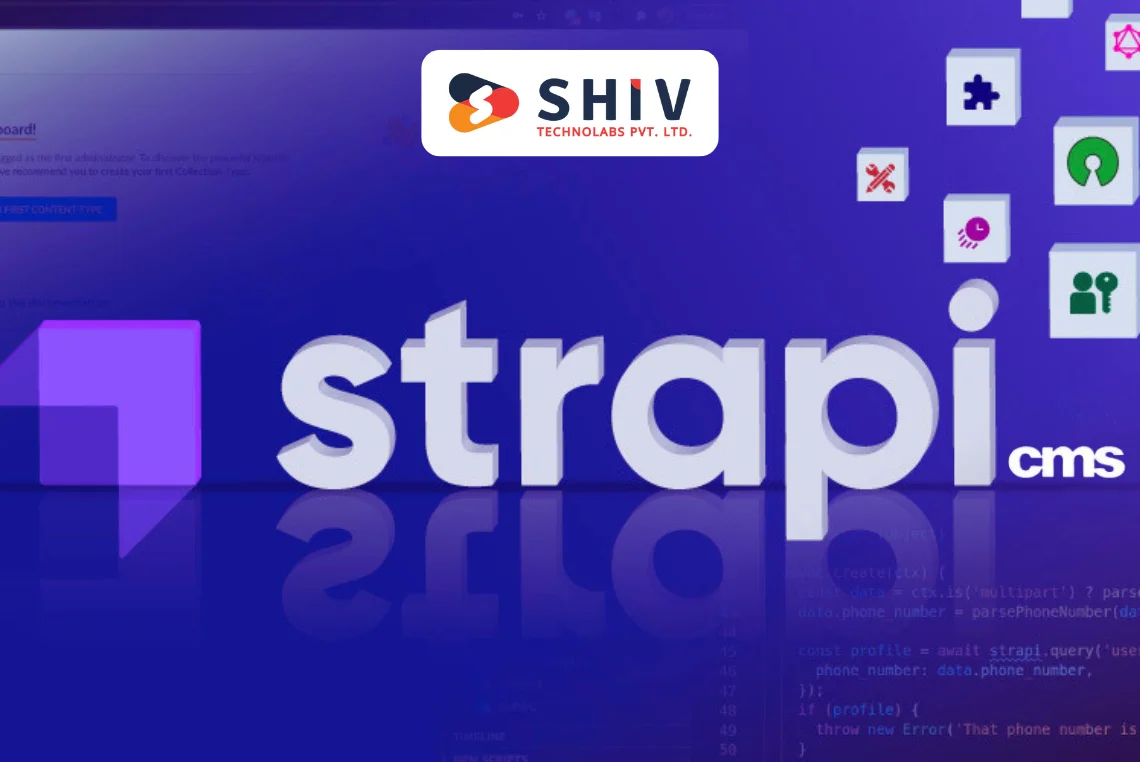Table of Contents
Speed is one of the most critical factors in online shopping. Research shows that 53% of users abandon a website if it takes longer than three seconds to load. Additionally, studies indicate that a one-second delay in page load time can reduce conversions by up to 7%. In eCommerce, where competition is fierce, even small delays can result in lost revenue.
Google’s Core Web Vitals has made website performance a key ranking factor, meaning that faster websites do not just attract more visitors but also rank higher in search results. Traditional eCommerce platforms often struggle with slow load times due to heavy themes, complex databases, and excessive third-party scripts. This is where Next.js and Headless CMS come in, offering modern solutions to build high-speed, efficient, and scalable online stores.
Many leading online businesses have already adopted these technologies to improve speed and performance. Brands like Nike, Target, and Walmart use Next.js for their front-end development, while companies like Netflix and Shopify integrate Headless CMS platforms to manage content efficiently.
If you want to create a faster and more responsive online store, using Next.js development services with a Headless CMS can significantly improve performance. Let’s look at what they are and how they work together to improve website speed.
What Makes Next.js and Headless CMS a Great Choice for eCommerce?

Before understanding how they improve speed, let’s first break down what these technologies are and why businesses use them.
# What is Next.js?
Next.js is a React-based framework designed for building high-performance websites and applications. It supports:
- Server-Side Rendering (SSR) – Pages load faster by processing content on the server before reaching the user.
- Static Site Generation (SSG) – Pre-built pages load instantly, improving site performance.
- Incremental Static Regeneration (ISR) – Allows updates to specific pages without rebuilding the entire website.
These features help reduce load times, making websites fast, responsive, and user-friendly.
# What is a Headless CMS?
A Headless CMS is a content management system that separates the front end (the website’s design and interface) from the back end (where content is stored and managed). Instead of being tied to a specific website framework, content is delivered through APIs, allowing it to be displayed on any platform, such as websites, mobile apps, or even smart devices.
Businesses looking to improve flexibility and speed in their eCommerce operations are increasingly turning to Shopify headless commerce, which allows Shopify to function as the backend while Next.js powers a fast, custom storefront.
Popular Headless CMS options include:
- Strapi
- Sanity
- Contentful
- Prismic
- DatoCMS
By combining Next.js and a Headless CMS, businesses can build lightweight and efficient eCommerce websites that perform better than traditional platforms, offering better user experiences and faster load times.
How Next.js and Headless CMS Improve Your Store’s Speed
A slow online store not only frustrates users but also reduces search rankings and conversion rates. Here’s how Next.js and a Headless CMS help improve website speed and performance.
1. Faster Page Loads with Server-Side Rendering (SSR)
One of the main reasons websites feel slow is because the browser has to process too much data before displaying content. With Server-Side Rendering (SSR), Next.js processes the page on the server before sending it to the user, reducing the time it takes to load.
For eCommerce websites, this means:
- Product pages load quickly, even when displaying large amounts of data.
- Customers see real-time stock updates without refreshing the page.
- Checkout pages remain fast and responsive, reducing cart abandonment.
2. Instant Page Loads with Static Site Generation (SSG)
Static pages load faster because they are pre-built before a user requests them. Next.js pre-generates pages at build time, making them instantly available when someone visits the website.
This approach is ideal for:
- Homepages
- Product listing pages
- Blog posts and content pages
Since these pages do not change frequently, they can be pre-built, reducing server load and making browsing feel effortless.
3. Real-Time Updates Without Slowdowns Using Incremental Static Regeneration (ISR)
A common issue with static websites is that once they are built, they do not update automatically. Incremental Static Regeneration (ISR) solves this by allowing updates to specific pages without rebuilding the entire website.
For example:
- If a product price changes, only that product’s page updates while the rest of the website remains unchanged.
- New blog posts can be added without affecting the speed of the existing site.
- Inventory updates happen in real time without slowing down the store.
This makes Next.js a great choice for eCommerce websites that require both speed and dynamic updates.
4. Lightweight Content Delivery with Headless CMS
Traditional CMS platforms, such as WordPress, load a lot of unnecessary scripts and data that slow down the website. A Headless CMS delivers content through APIs, meaning only the required data is loaded, improving performance.
Advantages of using a Headless CMS:
- No bloated themes or plugins that slow down the website.
- Faster API-driven content delivery, reducing page load times.
- Easier content updates without affecting website performance.
With this approach, businesses can keep content fresh and relevant without compromising speed.
5. Optimized Images for Faster Load Times
Images are one of the biggest factors affecting website speed. Next.js provides built-in image optimization, reducing file sizes while maintaining quality.
Key benefits include:
- Automatic lazy loading – Images only load when needed, reducing initial page load time.
- Responsive images – Different image sizes are served based on the device, making mobile browsing faster.
- WebP support – Next.js automatically converts images to WebP, a more efficient format.
This ensures that product images look great while keeping the website fast.
6. Faster Global Performance with Edge Caching
By using Content Delivery Networks (CDNs), Next.js can cache website data on servers worldwide. This means users in different locations experience fast load times, regardless of where they are accessing the store from.
CDN caching helps by:
- Reducing latency for international users.
- Decreasing server load by delivering cached content.
- Keeping website response times low, even during high traffic.
7. Smaller JavaScript Bundles for Faster Interaction
Many eCommerce websites suffer from large JavaScript files that slow down interaction. Next.js splits code into smaller bundles, loading only what is necessary for each page.
This means:
- Users can interact with buttons, menus, and filters without delays.
- Checkout and payment pages load quickly, preventing frustration.
- The overall user experience feels smoother and more responsive.
Best Practices for Implementing Next.js and Headless CMS in eCommerce

Using Next.js with a Headless CMS can significantly improve the speed and performance of an eCommerce website. However, to get the most out of this setup, certain best practices should be followed.
1. Choose a Headless CMS that Supports GraphQL
GraphQL allows the front-end to request only the data it needs, reducing load times and improving efficiency. Many modern Headless CMS platforms, such as Contentful and Sanity, support GraphQL, making them a great choice for eCommerce projects. With the right front-end development services, businesses can integrate GraphQL effectively, ensuring faster performance and a more responsive user experience.
2. Use Static Site Generation for Non-Dynamic Pages
Pages that do not change frequently, such as homepages, product category pages, and landing pages, should be pre-built using Static Site Generation (SSG). This ensures these pages load instantly for users while reducing server load.
3. Implement Server-Side Rendering for Dynamic Content
For pages that require real-time updates, such as product detail pages, checkout pages, and user dashboards, Server-Side Rendering (SSR) should be used. This approach keeps the data fresh without compromising speed.
4. Optimize API Requests for Faster Content Delivery
Since Headless CMS platforms serve content via APIs, it is essential to structure API requests efficiently. Avoid fetching unnecessary data, and batch requests when possible, and cache frequently accessed content to reduce response times.
5. Use a Global Content Delivery Network (CDN)
Deploying Next.js applications with a CDN, such as Vercel or Cloudflare, improves speed by delivering content from servers located closer to users. This reduces latency and enhances performance for global audiences.
6. Enable Lazy Loading for Images and Scripts
To prevent unnecessary delays in page loading, use lazy loading for images and third-party scripts. Next.js has built-in image optimization features that automatically serve optimized images based on the user’s device and network conditions.
7. Monitor Performance and Continuously Improve
Regularly test the website’s speed and performance using tools like Google PageSpeed Insights, Lighthouse, and GTmetrix. Identify bottlenecks, optimize code, and update dependencies to maintain high performance.
Get a Faster, More Efficient Store with Shiv Technolabs
Building a high-performing eCommerce store requires expertise in both Next.js and Headless CMS platforms. At Shiv Technolabs, a trusted Next.js development company in France, we specialize in creating online stores that are designed for speed, scalability, and efficiency.
# Why Work With Us?
- Custom Next.js Development – Our team builds eCommerce stores with modern performance-driven architectures.
- Seamless Headless CMS Integration – We connect your store with platforms like Strapi, Sanity, or Contentful for efficient content management.
- Mobile-First and SEO-Friendly Approach – We optimize websites for speed and mobile responsiveness, improving rankings and conversions.
- Ongoing Support and Maintenance – From security updates to feature enhancements, we ensure your store performs at its best.
Looking for a Next.js-powered eCommerce store that delivers speed and reliability?
Conclusion
The combination of Next.js and a Headless CMS is redefining how eCommerce websites are built, focusing on speed, flexibility, and user experience. By adopting best practices such as Static Site Generation, Server-Side Rendering, and API-first content delivery, businesses can create high-performance stores that drive conversions.
If you want to build a high-speed, scalable, and future-ready eCommerce store, Next.js and Headless CMS provide the perfect solution. With faster load times, seamless content management, and improved flexibility, your store can deliver a superior shopping experience. At Shiv Technolabs, a leading Next.js development company, we help businesses create cutting-edge online stores that drive sales and engagement. Ready to take your eCommerce store to the next level? Get in touch with our experts today!






















